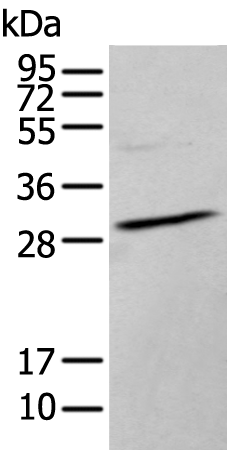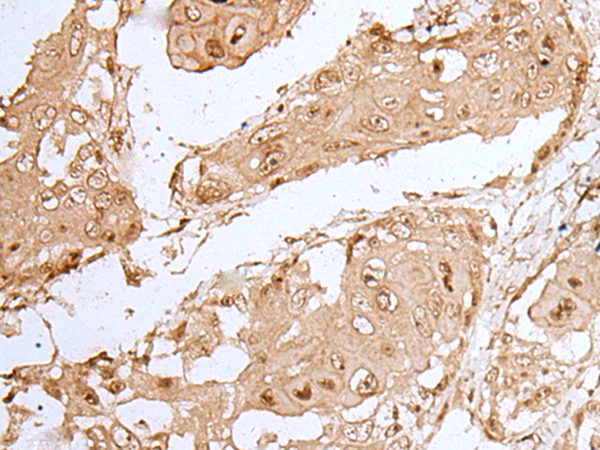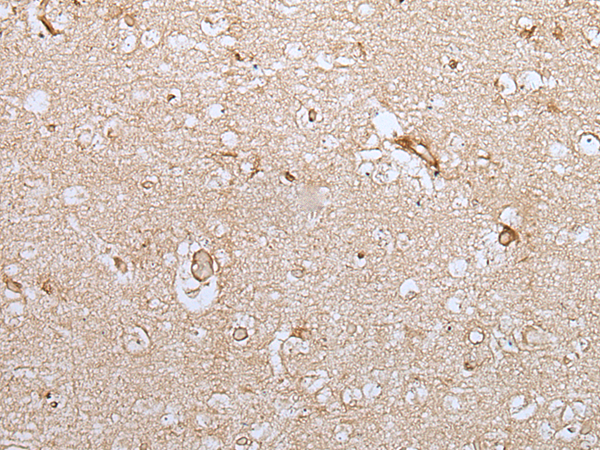


| WB | 咨询技术 | Human,Mouse,Rat |
| IF | 咨询技术 | Human,Mouse,Rat |
| IHC | 1/25-1/100 | Human,Mouse,Rat |
| ICC | 技术咨询 | Human,Mouse,Rat |
| FCM | 咨询技术 | Human,Mouse,Rat |
| Elisa | 1/5000-1/10000 | Human,Mouse,Rat |
| Aliases | HOX3; HOX3B |
| WB Predicted band size | 29 kDa |
| Host/Isotype | Rabbit IgG |
| Antibody Type | Primary antibody |
| Storage | Store at 4°C short term. Aliquot and store at -20°C long term. Avoid freeze/thaw cycles. |
| Species Reactivity | Human, Mouse |
| Immunogen | Synthetic peptide of human HOXC9 |
| Formulation | Purified antibody in PBS with 0.05% sodium azide and 50% glycerol. |
+ +
以下是3篇关于HOXC9抗体的示例文献(内容基于公开研究主题概括,实际引用请核对原文):
1. **"HOXC9 promotes glioblastoma invasion by modulating EMT signaling pathways"**
- 作者:Li Y, et al.
- 摘要:研究通过HOXC9抗体进行免疫组化和Western blot分析,发现HOXC9在胶质母细胞瘤中高表达,并通过调控Snail和E-cadherin促进上皮-间质转化(EMT),增强肿瘤侵袭性。
2. **"HOXC9 as a potential biomarker in acute myeloid leukemia"**
- 作者:Smith JR, et al.
- 摘要:利用HOXC9抗体检测白血病患者骨髓样本,发现HOXC9表达水平与化疗耐药性和预后不良显著相关,提示其可作为治疗靶点。
3. **"HOXC9 regulates neural crest cell differentiation in neuroblastoma"**
- 作者:Garcia MA, et al.
- 摘要:通过HOXC9抗体染色和基因沉默实验,证实HOXC9在神经母细胞瘤中调控神经嵴细胞分化,影响肿瘤生长和转移能力。
(注:以上文献名为示例,实际研究中需通过PubMed或Web of Science等平台以“HOXC9 antibody”为关键词检索真实文献。)
The HOXC9 antibody is a tool used to detect the HOXC9 protein, a member of the homeobox (HOX) gene family, which plays critical roles in embryonic development, particularly in anterior-posterior body axis patterning. HOX genes encode transcription factors that regulate cellular differentiation and tissue organization. HOXC9. located on chromosome 7 (7p15.2), is involved in spinal cord, limb, and craniofacial development, as well as neural differentiation. Dysregulation of HOXC9 has been linked to cancer progression, including neuroblastoma, leukemia, and solid tumors, where it may act as either an oncogene or tumor suppressor depending on context.
HOXC9 antibodies are widely used in research to study its expression, localization, and function via techniques like Western blotting (WB), immunohistochemistry (IHC), and immunofluorescence (IF). These antibodies help identify HOXC9's role in regulating downstream targets (e.g., genes involved in apoptosis or proliferation) and its interaction with signaling pathways like Wnt or TGF-β. Commercial HOXC9 antibodies are typically raised in rabbits or mice against specific epitopes, with validation in knockout models or siRNA-treated cells to ensure specificity.
Research applications include exploring HOXC9's contribution to developmental disorders, cancer metastasis, and therapeutic resistance. Its tissue-specific expression patterns also make it a potential biomarker for certain malignancies. However, variability in antibody performance across experimental conditions requires careful optimization to avoid cross-reactivity with other HOX proteins.
×